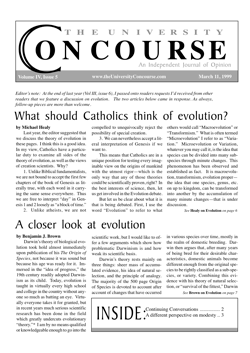A different perspective on the modesty question
by Kathleen van Schaijik
Regina Doman Schmiedicke has made some very worthwhile points about the relation between proper dress and personal dignity, about the attractive power of authentic modesty, and about the uncharitableness-toward-men of immodesty. But I am afraid some misplaced emphases and an undue rigorism in her view might get in the way of the good she’d like to help bring about in this area.
For instance, I think it a mistake to put so much emphasis on the danger of tempting men to sin. It is certainly a part of the problem, but it is at most only a secondary part. Treating it as if it were the “main point” of modest dress can make matters worse, in two ways. For some it will only aggravate the puritanical tendency Regina rightly lamented for causing many women to dress in ugly, bag-like clothing that hides their shape. If the main idea of modesty is seeing to it that we don’t tempt our brothers to sin, then obviously the more invisible we make our figures the better. Modesty is reduced to it’s negative aspect, i.e. sexual-sin-avoidance. It’s deeper essence as reverence for the sexual sphere is down-played or lost entirely.1
An over-emphasis on the “temptation factor” might lead others to conclude that immodesty is not really a serious problem at all. Too many women will think: “Please, I am not so deluded as to imagine that the sight of my bare knees is titillating enough to send the men around me running for the confessional.” And too many men will think: “I don’t know what kind of guys you’re hanging out with, but speaking for myself, it’s just not such a big deal.” Maybe they’re in denial; maybe they’ve been inured by decades of sensory overload; maybe they’re just naturally less highly-charged than other men, or maybe their taste has been so well-formed that they are more repelled than attracted by immodesty—whatever the reason, it seems to me a fact that there are plenty of men out there for whom short skirts and sleeveless shirts do not automatically give rise to a struggle with impurity. I don’t say this is necessarily a good thing; I only say it shows that the temptation factor is not the heart of the issue. If it were, then where there was no temptation there would be no problem, whereas in reality, indifference to the human body is a serious disorder, particularly widespread today. It has come about by the licentiousness and irreverence for human sexuality that characterize our age,2 and it, at least as much as anything else, shows how urgently we need to recover a sense of modesty.3
Further, though there may well be something to Regina’s idea of there being a historical relation between robes and social standing, I think she goes way too far when she links the loss of that symbolism so directly with “the advent of more effective birth control”—as if the sexual revolution were the only event of the century. It makes the change in women’s fashions into an absolute evil—as if every woman who doesn’t wear “robes” is declaring her sexual availability, consciously or not. Is it not much more plausible to say that as women began to move more freely in society, they began to dispense with “robes” simply because they found it easier to do the sort of things they wanted to do without them? (Who could deny that things like housework and gardening and sports and traveling, for instance, are much easier in pants?) We might very well want to argue that what women lost in respect when they began wearing pants was worth much more than what they have gained in comfort and social mobility, but we can do that more effectively, I think, if we don’t overshoot our mark.
It is similarly overdoing things to say that no Catholic woman should wear anything the Blessed Mother wouldn’t wear. As a mutual friend of Regina’s and mine pointed out, Our Lady is both a mother and a consecrated virgin. To say that no one should wear what the Blessed Mother wouldn’t wear would be the same as to say all women should dress as if they were consecrated virgins. A nun wears a habit as an outward sign of her virginity. That sign would have no meaning unless there were a natural distinction between the way married women and virgins dress.
If we want to persuade women to dress more modestly, we would do well to avoid both exaggerated analyses of the problem and too-extreme solutions to it. We should show more sympathy with legitimate concerns for comfort, practicality and stylishness, and be more modest, so to say, in our calls for reform.
A few years ago, when we lived in Steubenville, a women’s household asked me to come to campus and give them a talk on self-respect and its modern counterfeits. I spoke a lot about the importance of modesty. I told them how if we dress in a way that draws attention to our sexuality to the neglect of our personality, we will get the wrong kind of attention from the wrong kind of men. The good ones will turn the other way, and the bad ones will turn dangerous. If we want to be recognized and respected for who we are in our deepest essence, we should have nothing to do with the my-bod-in-your-face fashions of today. In clothes like that everything about a woman except her sexual value is pushed into the background, while her body is thrust into the public glare for comparison with all the bodies in Hollywood. If she happens to have an especially good figure, she will certainly attract a lot of attention, but it will be the degrading attention of impure men. If her figure is not so attractive, she will feel mortified by rejection, and tempted to self-hatred.
The girls listened intently and eagerly. One of them said, “You are so right. Last week we were going dancing in Pittsburgh, so I put on my sluttiest shirt, and it was nothing, I mean nothing, to what the other girls there were wearing!” That was the word she chose. She wore her sluttiest shirt. She said it jokingly, and her friends laughed. But I wanted to burst into tears.
Things have gone farther than we realize. We are a million miles away from the “Pope’s rules” for the Catholic high schools of the 1940 and 50s. Girls whose sense of modesty has been formed in a culture where “looking great” is understood to be synonymous with “looking hot” are not about to take seriously a decades-old dress code stipulating the number of inches below the knee, elbow and collarbone. It is simply too remote from their experience. It will only serve to confirm their impression that those who talk that way are completely out of touch with reality.
Then, there are other reasons why people who are all in favor of more modesty might reject the idea of establishing a set of rules to dress by. One is that by their nature rules breed legalism, judgementalism and hypocrisy. (Fallen creatures that we are, we can’t live well without any rules at all, but we seem to thrive best when they are kept to a minimum.) This is especially the case where a real grasp on the deep moral values involved is weak or missing, as is the case with regard to modesty in today’s society. Consider, for instance, how easily we backfire by confusing our external conformity to a set of rules with possession of virtue itself. Because I adhere to an especially strict standard of body-coverage, I imagine myself to be particularly modest; I imagine that that person next to me, whose skirt is two inches shorter, is less modest than I am.
It goes without saying that there is an essential connection between inward modesty and its outward expression, but the two are not the same thing. Virtue cannot be measured in inches, and there is much more to modesty than conservative clothing. (For instance, I personally think “stretching out on the floor to watch television”—except perhaps in the intimate confines of the family—is at least as much at odds with the ideal essence of feminine modesty as short skirts are.)
Let’s forget about rules and dress codes for now. Let’s instead try harder to instill in one another a deeper appreciation of the nature and dignity of the human person; a better understanding of the meaning of the human body, and a profound sense of reverence for the sexual sphere. (If I had more space I’d start right here! Maybe next issue.) If we manage this authentic modesty will come of itself.
Kathleen (Healy, ‘88) van Schaijik is Editor of the Concourse.
- If we revere something, we do not hide it. Neither do we flaunt it in public. We cherish it; we pay it homage; we approach it with dignity; we adorn it with beauty; we take care that it is not misused. ↑
- In classical vicious circle fashion it also adds to the problem of licentiousness, of course. People who are ho-hum about human sexuality are more like to engage in it casually, or else to seek thrills through various forms inhuman sexuality. ↑
- One part of Regina’s article shows that she is very well aware of this aspect of the issue. But I still think the combination of her too-heavy emphasis on temptation and her lack of discussion of right-reverence for the sexual sphere might have an effect opposite to the one she intends. ↑


